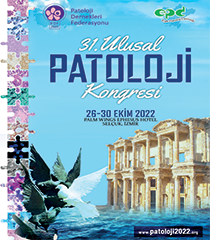Güncel Patoloji Dergisi
2018 , Vol 2 , Num 2
The influence of Polyomavirus infected glomerular cells on the development of glomerulopathy and the graft survival
1 Başkent University, Departments Of Pathology, 2 Başkent University, Departments Of Nephrology , 3 Başkent University, Departments Of Transplant Surgery
Özet
IntroductionThe importance of SV-40 positive parietal cells in glomeruli is unknown. The aim of this study is two-fold; first to evaluate the relationship between histological findings such as the development of glomerulopathy (GP) with glomerular SV-40 expression, second to understand the impact of glomerular polyomavirus (GPV) involvement to the graft survival.
Material and Method
Total 71 PVN cases included into the study. All biopsies re-evaluated and follow-up biopsies examined for the development of interstitial fibrosis (IF) and GP. Interstitial neutrophil, plasma cells, CD3, CD4, CD8 positive lymphocytes, and macrophages graded. Clinical data retrieved from patients' records.
Results
The mean interval between PVN and transplant was 17±22 months. Glomerular SV40 was positive in 20 cases (28,2%). During follow-up 39 cases had proteinuria, but only 19 (26.7%) developed GP and 43 (60,6%) developed IF. The mean viral load in urine and plasma at diagnosis was higher in GVP(+) than that GVP(-) (p<0,001). Compared to GVP(-), the degree of the interstitial neutrophil, plasma, macrophage and lymphocyte infiltration found higher in GVP(+) (p<0.01). The presence of TMA, Pvl 3, CMV viremia at the time of PVN found higher in GVP(+) cases (p<0.05). The rate of the development of GN and IF noted higher in GVP(+) than that GVP(- (p=0.001). Mean 35,8±27 months follow-up after PVN, rates of graft loss was higher in GVP(+) (95%) than GVP(-) (25,5%) (p<0.001).
Conclusion
The presence of the SV-40 positive parietal cells in glomeruli pointed out the poor prognosis. Thus it is essential to generate a different therapy schedule for patients with GPV.


